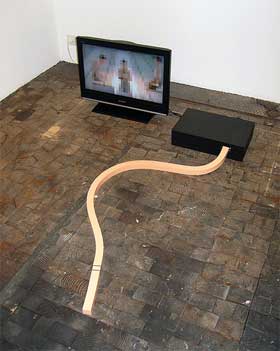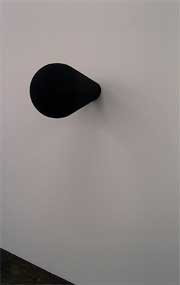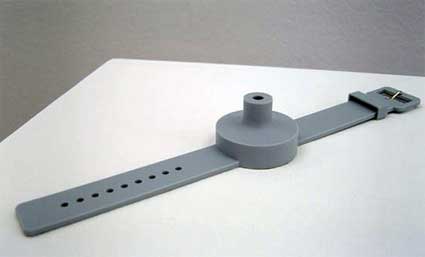Do you want to replace the existing normal?, a collaboration between Fiona Raby, Anthony Dunne and Michael Anastassiades, looks at designing for complicated or irrational needs… Just like their previous Anxious Times project did a few years ago, but this time, the designers focused on electronic products rather than furniture.
 S.O.C.D
S.O.C.D
The work, which was partly supported by the Arts Council is currently part of Wouldn’t it be nice, an exhibition, curated by Katya Garcia-Anton and Emily King, which addresses the application of wishful thinking in art and design today. You can visit the show until December 16 at the Centre d’Art Contemporain in Geneva, then at the Museum für Gestaltung in Zürich. After their litle Swiss tour, the objects will fly to New York to be part of MOMA‘s upcoming exhibition Design and the Elastic Mind (February 24–May 12, 2008).
There will be 5 objects altogether, here are the first ones:
S.O.C.D* is for people who enjoy porn but feel a bit guilty watching it, or think that it’s wrong. You put a dvd into the black box and hold onto the rubber part of the object. The long bit is made of rubber, it’s shiny and soft like a dildo, except that the section is square. The metal bits sense your level of arousal and pixelate the image accordingly in real time. The more you get aroused, the bigger the pixel size, and the more distorted the sound gets. If you let go the film goes blank.
To enjoy your porn video, you need to hold on but try to de-arouse yourself at the same time, which parallels your contradictory feelings.
Electronics: Erik Kearney, software: David Muth.
 The Statistical Clock checks the BBC website for technologically mediated fatalities: car, train, plane, etc and pulls them into a database. The clock checks it every minute or so, and each time it finds a new one it speaks it out loud… 1, 2, 3, etc. The way the object works was partly inspired by the Number Stations‘, you pick them up on short wave radio and can hear usually a female reading streams of numbers, words, letters, tunes or morse code. They were probably used by spies in conjunction with one-off code books that could only be used on a specific day with a specific chain of numbers.
The Statistical Clock checks the BBC website for technologically mediated fatalities: car, train, plane, etc and pulls them into a database. The clock checks it every minute or so, and each time it finds a new one it speaks it out loud… 1, 2, 3, etc. The way the object works was partly inspired by the Number Stations‘, you pick them up on short wave radio and can hear usually a female reading streams of numbers, words, letters, tunes or morse code. They were probably used by spies in conjunction with one-off code books that could only be used on a specific day with a specific chain of numbers.
Each technology has its own channel on The Statistical Clock. You can select the channel you want to listen to. The object is meant to re-sensitise you. When you read about deaths or see them on the news they don’t really have any impact. But if the clock suddenly says ‘1’ and you are eating your dinner, you are much more likely to find it disturbing. That feeling reconnects you with the reality behind the statistics. It’s not intended to be morbid, but to genuinely give meaning back to something we just take for granted.
The object is made from acoustically transparent foam, like the material used for speaker covers, it’s 600 mm long and 400 mm diameter at its widest.
Electronics and programming: Chris Hand.
The Risk Watch speaks a number when you place it to your ear, the rubber deflects and activates a specially built device inside. The number corresponds to the political stability of a country.

This watch is not connected to the telcoms network right now, but if it was, it would subscribe to one of several commercial providers of up-to-date risk assessments usually beamed to employees’ blackberrys. There are 5 levels. It’s meant to be reassuring when in an unstable country and relates to local geographic position.
Electronics: Erik Kearney.
The Herald Tribune has a review of the exhibition.
All Images courtesy of Anthony Dunne.
* s.o.c.d stands for sexual obsessive compulsive disorder.
